Creswick - Calembeen Park

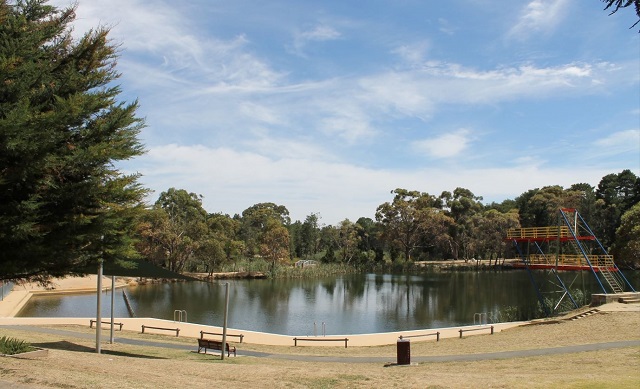
Calembeen Park's lakes are home to birdlife and waterlily displays. Chinese miners first mined here for shallow alluvial gold between the 1850s and 1860s and it became a Chinese settlement. The first recorded use for swimming was around 1910 and Calambeen Park's lakes are now popular for swimming, fishing, walking and cycling.
The restoration of the historic dive tower in recent years has seen many visitors return to the reserve.
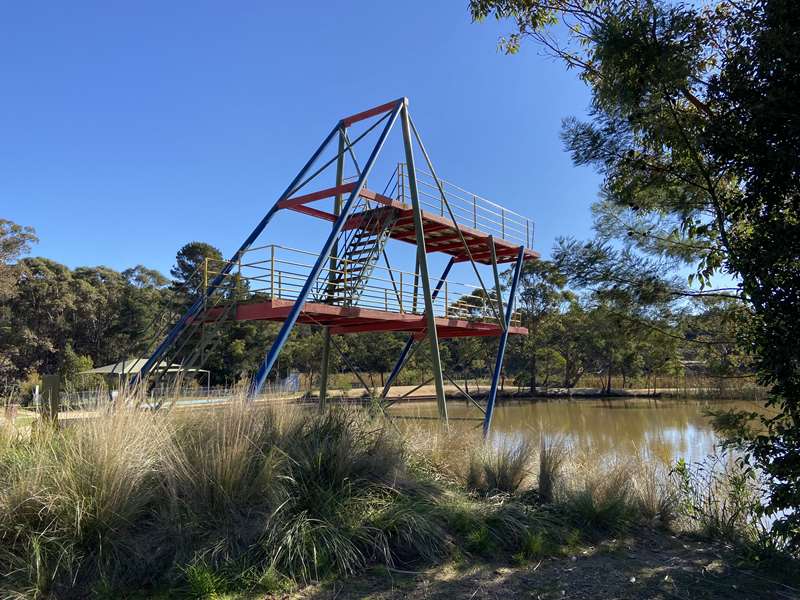
There is a swimming pool within the largest pond, a wading pool, toddlers pool and diving tower. The depth of the main swimming area ranges from 1-30m and there is a sudden steep drop-off. However on the side there is a shallow area suitable for children.
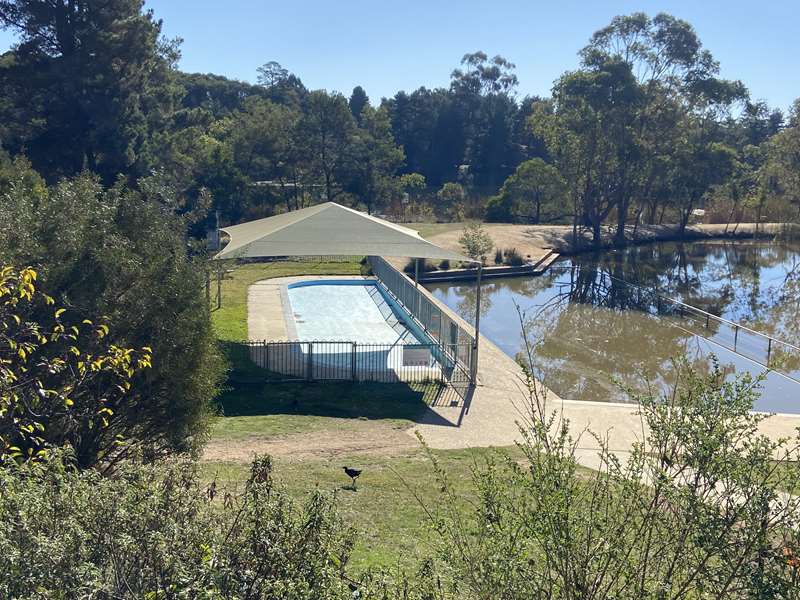
In the shallow toddlers pool, all children must be supervised by an adult at all times. Children over 8 years are prohibited from this pool. No dogs are allowed in this pool.
There is also a picnic area, BBQ, amenities block and nature walks.
The reserve is also home to the public art piece 'My Dearest', which can be found along the walking trail around the lake.

Walking Track
From Cushing Avenue join the 1.3km, 45 minute walking and cycling track that forms a figure eight around the two lakes. The path is a wide gravel-surfaced track and a great place for the whole family.
Map of Walk Route
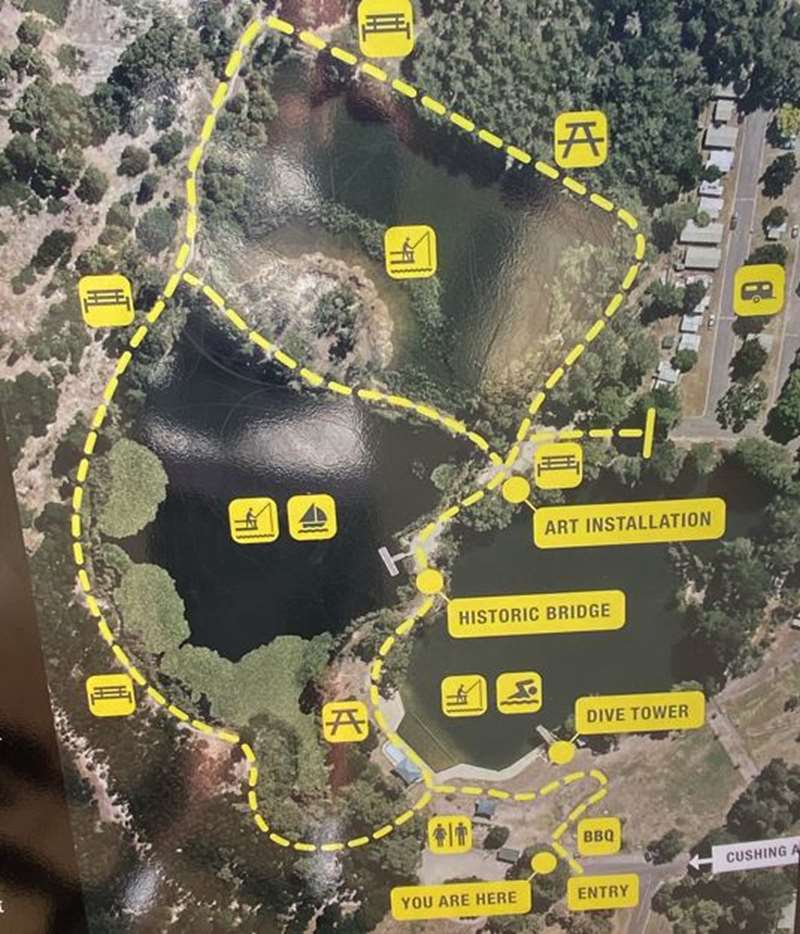
Access for Dogs:
Dogs are allowed on leash.
A Rich History...
(a) Calembeen Park area and surrounds were mined for shallow alluvial gold between the early 1850s and the early 1860s. This area was worked over by Chinese miners and became the site of a Chinese settlement occupied until the late nineteenth century.
(b) In the late 1890s the Black Lead Hydraulic Sluicing Company mined deeper to deposits which extend beneath the site, creating large excavations which subsequently became the Calembeen Park swimming basin. (c) The first recorded use of the site for swimming was around 1910, shortly after a step was cut into the earth bank for easier access. A wading pool bounded by a paling fence was established in 1912 and in 1916 a temporary reserve for a public park was gazetted - including the area to the east now occupied by the caravan park.
(d) The gates at Calembeen Park were erected as part of the Centenary Celebrations. They were opened officially at 3pm on Sunday October 5th, 1952.
(e) In the 25 years following 1910, numerous facilities were developed, including a kiosk, timber diving tower, spring boards, dressing boxes, electric lighting and spectator seating. As a result of its grand development, Calembeen Park was described by Olympic swimming champion, politician and businessman Frank Beaurepaire as "Victoria's finest inland swimming basin".
Gold and Guilt
This location was once the famous Black Lead diggings. At the height of the boom in the 1850s between three and six thousand Chinese miners lived here.
Shops, opium dens, joss houses and shacks were arranged along two streets. The miners reworked abandoned mines, extracting every speck of gold. Most hoped to return, wealthy, to their country and families. While here they continued many of their own cultural customs.
Chinese theatre groups were extremely popular. They had begun visiting the gold fields shortly after the rush had started. Between 1858 and 1869 some fourteen companies, with up to fifty performers, toured. The miners also grew their own vegetables and many of those who stayed in Australia set up successful market gardens. Creswick's Chinese community contributed considerable money to charitable causes, including the building of the hospital.
The Chinese ramp was our Paradise. Here were two joss-houses, from which the burning joss-sticks could be looted, and here lived a wizened old Chow called Sinkum who would match his inimitable (peanut toffee) against our pennies. At the entry of the Chinese camp stood the dwelling Ginger Mary Ann, a bedraggled representative of the oldest profession on earth... and sometimes we would see the ginger beer maker. But our business was with Sinkum the toffee-maker, and we debated the inevitable alternative - should we toss or buy? - Lionel Lindsay
Eureka: the Creswick Connection
In late October 1854, the road to the Government Camp at Creswick Creek was crowded with diggers so incensed by the oppressive license system and general injustice that they threatened to burn the Camp, and demanded the removal of all officials.
The protest was quelled, but the anger returned on 25 November when delegates from Ballarat's vigorous Reform League rode in to seek support for their democratic protest and their condemnation of overbearing and unjust Ballarat officials.
Four days later, about 2,000 men, from the population of 25,000, met at Long Point to promise support. Licenses were burnt and, led by a German band, a contingent of about 150 set off for Ballarat travelling via Clarke's Flat and Black Lead, encouraging fellow miners to join them.
Legend has it that some were caught in a thunderstorm at Mopoke and returned home. Yet it is recorded that about 500 Creswick men arrived at the stockade in Ballarat on 1 December 1854.
The Creswick men joined the Ballarat men in their defensive stockade, standing up for their rights and liberties. The Stockaders were no match for the Government forces, who stormed the stockade and even massacred bystanders early on the morning of 3 December.
Cost:
Access and swimming is free.
Review:
A lovely area to visit either for a swim, dive or picnic during the warmer months or for a walk around the lakes. Near the car park there are three unshaded tables, shaded BBQ, shelter with two tables, water tap and toilets on the edge of a grassy area.
Near the lake is a shade sail over a patch of grass, shaded toddler pool and a scary two level diving platform.
There is a nice walk which weaves around and between the lakes where there is some interesting large scale artwork and a fishing jetty. On the walk there's plenty of tables and seats. There is plenty of birdlife around the lakes.
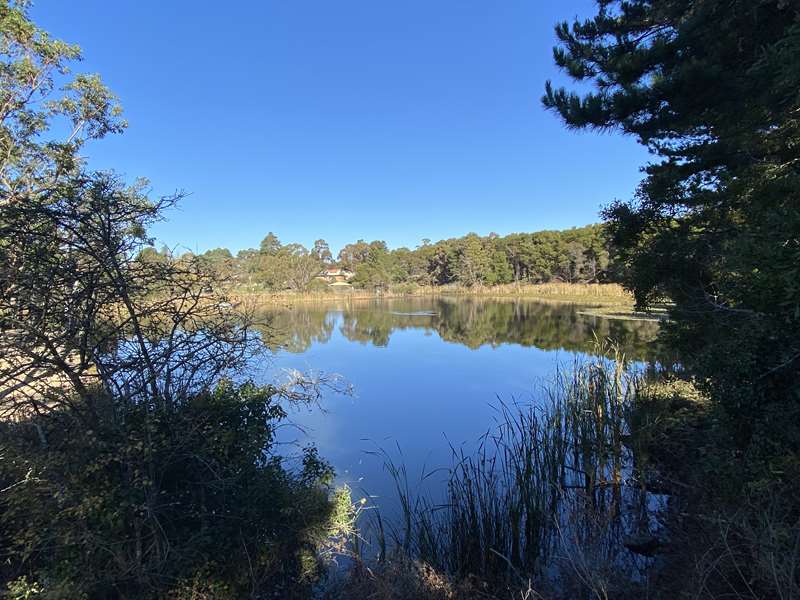
In the second lake fishing and sailing are permitted but swimming is not permitted.
Photos:
Location
14 Cushing Avenue, Creswick 3363 View Map
Web Links
→ Calembeen Park on Facebook
→ Hepburn Council Swimming Pools









